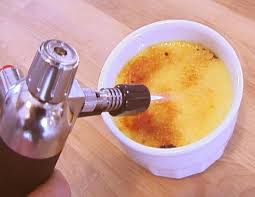In the past several weeks, my lovely wife Adriane has been making our daughter Macy fresh, organic purees of baby food. Yesterday we went to Whole Foods and purchased a butternut squash, some ground turkey and a bag of beautiful petite Fuji apples. Adriane decided to roast the squash by cutting it in halve length wise and removing the seeds. Then she rubbed the inside liberally with virgin olive oil, seasoned it with kosher salt and very little fresh ground pepper. On a baking pan she put the squash, cut side down, after she put a bay leaf and a thyme sprig in the cavity where the seeds were. The squash was roasted at 375 degrees for approximately 45 minutes, depending on the size of the squash. If you put a little water in the pan while roasting it shouldn't burn. The flesh should be very soft.
While the squash was roasting, Adriane sautéed some of the ground turkey with a peeled, seeded and chopped apple until the apple was soft and the turkey cooked through. In our brand new Kitchen Aid Blender (which we absolutely love) she blended the turkey, apple and roasted squash together until velvety smooth. Two thumbs up were given by Macy Rose.
After all was said and done, we had about 1/2 a pound of ground turkey and half a roasted butternut squash left over. Time to make some yum yums for mommy and daddy. Mommy made some turkey burgers with just the ground turkey meat and seasoning from a package of ranch dressing (a little MSG goes a long way). With the left over 1/2 of a roasted squash, I reheated it in the microwave then put the squash in the food processor and added about 2 tablespoons of softened butter, 1 tablespoon of maples syrup, a grind or two of fresh cinnamon, a dash of ground nutmeg, salt and fresh pepper and pureed it until it was velvety smooth. So we had the turkey burgers and the butternut squash puree ready to go, but we felt we needed something else to go with it. Digging through one of the produce drawers in the refrigerator, I found a package of mushrooms (shiitake, portobello, cremini). Perfect! I'll make a mushroom ragout in the same saute pan I fry the turkey burgers in. After cleaning the mushrooms thoroughly, I heated a sauté pan over medium high heat for a minute, then I added a splash or two of olive oil and swirled it around. After it started to shimmer and smoke a little bit I added the turkey burgers, which Adriane pattied out pretty thin so they would cook fast. After about 2 minutes on the first side, I flipped the burgers and cooked it for another 2 minutes until it was nice and golden brown on both sides. I took the burgers out of the sauté pan and set them aside in a warm place. The bottom of the sauté pan had this wonderful brown caramelization in it with a little bit of fat that I had to utilize. With the pan over medium heat I added the mushrooms, about 2 cups. The mushrooms were tossed around in the pan until they started to release their water, about 2 minutes. Then I added 1 tablespoon of chopped garlic to the pan and cooked for 1 minutes. After the garlic browned a touch I added 1 cup chicken stock, 1/4 cup of red wine and 3 thyme sprigs and reduced everything down until the mushrooms were just a little saucy. I took the pan off the heat and added 1 tablespoon of butter and swirled it around in the pan, then seasoned the mushroom ragout with kosher salt and fresh ground pepper and removed the thyme sprigs.
It's funny because after typing this all out it sounds like it took forever to cook but really this all happened in about 30 minutes, with the squash already being cooked of course. In the end, Macy Rose gets to enjoy the turkey apple squash puree for several days, and my wife and I got to enjoy a wonderful plate of food with hardly any effort at all. It was literally "thrown" together! Check it out:
If you are still reading this post then I've got your attention. Please comment on your thoughts. I would love to hear from you!
Cook and Be Well!
Chef Don Paleno





 Burnt Cream is Gooood!
Burnt Cream is Gooood!